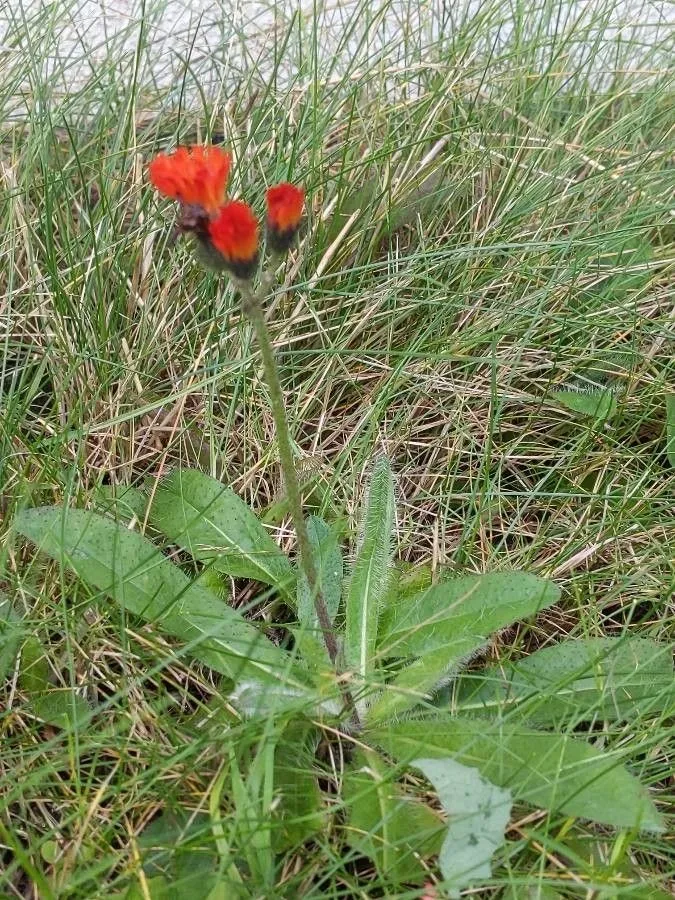
Author: (L.) F.W.Schultz & Sch.Bip.
Bibliography: Flora 45(27): 426 (1862)
Year: 1862
Status: accepted
Rank: species
Genus: Pilosella
Vegetable: False
Observations: Europe
Fox-and-cubs, scientifically known as Pilosella aurantiaca, is a captivating perennial herb that commonly graces various landscapes across Europe. This vibrant plant belongs to the Asteraceae family, a group renowned for its composite flowers and ecological importance.
First documented in the mid-19th century, the formal description of Pilosella aurantiaca appeared in Flora 45(27): 426 in 1862. The authority for this classification is attributed to (L.) F.W. Schultz & Sch. Bip., who recognized and meticulously described its distinctive characteristics.
Fox-and-cubs is widely admired for its radiant, fiery-orange blossoms, which bloom from late spring to early autumn, adorning meadows, roadsides, and garden spaces with a splash of color. Each flower head is composed of numerous tiny florets, creating a fuzzy appearance that attracts a range of pollinators, including bees and butterflies.
This plant’s ability to thrive in a variety of environments, from dry, sandy soils to lush, well-watered meadows, speaks to its resilience and adaptability. The leaves of Pilosella aurantiaca form a basal rosette, which helps conserve moisture and shade the root system against extreme weather conditions.
While Fox-and-cubs is celebrated for its ornamental beauty and ecological benefits, it is also noted for its vigorous growth and capacity to spread. Gardeners may find it both a delightful addition and a persistent invader if not properly managed. This adaptability and propagation can sometimes lead to its classification as a noxious weed in certain contexts outside its native range.
In summary, Pilosella aurantiaca merits appreciation not only for its aesthetic appeal and contribution to biodiversity but also for its robust nature. Whether spotted in the wilds of Europe or cultivated in a garden setting, Fox-and-cubs continues to fascinate botanists and plant enthusiasts alike with its striking appearance and dynamic growth patterns.
Lit: auksuotoji kudlė
Eng: devil’s-paintbrush, fox-and-cubs, king-devil, orange hawkweed, devil’s paintbrush, fox and cubs, king devil, orange-red king devil
Pol: jastrzębiec pomarañczowy
Ces: jestřábník oranžový
Deu: orangerotes mausohrhabichtskraut, orangerotes habichtskraut
Lav: oranžā pamauraga
Fra: piloselle orangée, épervière orangée, bouquets rouges, marguerite rouge
Dan: pomerans-høgeurt
Est: punane karutubakas
Ita: sparviere aureo
Swe: rödfibbla, rödfibbla/ängsfibbla
Ron: вултурикэ оранжэ
Bul: златиста румянка
Ukr: нечуйвiтер оранжево-червоний
Nld: oranje havikskruid
Nno: raudsvæve, hagesvæve, vanleg raudsvæve, vill raudsvæve
Sme: ruksesfivli
Nob: rødsveve, hagesveve, vanlig rødsveve, vill rødsveve
Cym: clust-y-llygoden euraid, heboglys aurafalog, heboglys euraid
En: Fox-and-cubs, Devil’s-paintbrush, King-devil, Orange hawkweed, Fox and Cubs, Devil’s paintbrush, King devil, Orange-red king devil, Grim-the-collier
Bg: Златиста румянка
Cs: Jestřábník oranžový
Da: Pomerans-høgeurt
Nl: Oranje havikskruid
Et: Punane karutubakas
Fr: Piloselle orangée, Épervière orangée, Bouquets rouges, Marguerite rouge
De: Orangerotes Mausohrhabichtskraut, Orangerotes Habichtskraut
It: Sparviere aureo
Lv: Oranžā pamauraga
Lt: Auksuotoji kudlė
Se: Ruksesfivli
Nb: Rødsveve, Hagesveve, Vanlig rødsveve, Vill rødsveve
Nn: Raudsvæve, Hagesvæve, Vanleg raudsvæve, Vill raudsvæve
Pl: Jastrzębiec pomarañczowy
Ro: Вултурикэ оранжэ
Sk: Chlpánik oranžový
Sv: Rödfibbla, Rödfibbla/ängsfibbla
Uk: Нечуйвiтер оранжево-червоний
Cy: Clust-y-Llygoden Euraid, Heboglys Aurafalog, Heboglys Euraid
Taken Oct 18, 2021 by Louineau Olivier (cc-by-sa)
Taken Oct 16, 2021 by Thijs van Son (cc-by-sa)
Taken Jul 12, 2018 by Jeroen De Pee (cc-by-sa)
Taken Jul 13, 2019 by Candice Christin (cc-by-sa)
Taken Feb 2, 2020 by Dominik Zentgraf (cc-by-sa)
Taken Jun 10, 2014 by Tela Botanica − Liliane Roubaudi (cc-by-sa)
Taken Jun 5, 2020 by Andrea Pausch (cc-by-sa)
Taken Jun 23, 2020 by Alain Bigou (cc-by-sa)
Taken Nov 2, 2022 by Sabina Hartmann (cc-by-sa)
Taken Oct 16, 2021 by Thijs van Son (cc-by-sa)
Taken Aug 6, 2019 by Alexis Brun (cc-by-sa)
Taken Jun 15, 2020 by Annette van Akker (cc-by-sa)
Taken Oct 13, 2021 by mike mike (cc-by-sa)
Taken Nov 2, 2022 by Sabina Hartmann (cc-by-sa)
Taken Oct 16, 2021 by Thijs van Son (cc-by-sa)
© copyright of the Board of Trustees of the Royal Botanic Gardens, Kew.
© copyright of the Board of Trustees of the Royal Botanic Gardens, Kew.
© copyright of the Board of Trustees of the Royal Botanic Gardens, Kew.
Taken Jun 24, 2017 by Yoan MARTIN (cc-by-sa)
Taken Jun 12, 2022 by Tristan Jaton-Maria (cc-by-sa)
Taken Jul 6, 2018 by Tela Botanica − Liliane Roubaudi (cc-by-sa)
Taken Jun 10, 2014 by Tela Botanica − Liliane Roubaudi (cc-by-sa)
Taken May 31, 2017 by Olivier Nicolas (cc-by-sa)
Taken Oct 7, 2022 by Caw Vus (cc-by-sa)
Taken Oct 18, 2022 by Jim Knopf (cc-by-sa)
Taken Jun 12, 2022 by Tristan Jaton-Maria (cc-by-sa)
Taken Jul 13, 2019 by Carole England (cc-by-sa)
Taken Aug 21, 2014 by Tela Botanica − Liliane Roubaudi (cc-by-sa)
Taken Aug 21, 2014 by Tela Botanica − Liliane Roubaudi (cc-by-sa)
Taken Aug 21, 2014 by Tela Botanica − Liliane Roubaudi (cc-by-sa)
Taken Aug 21, 2014 by Tela Botanica − Liliane Roubaudi (cc-by-sa)
Taken Aug 21, 2014 by Tela Botanica − Liliane Roubaudi (cc-by-sa)
Taken Jul 26, 2020 by Michael Hinds (cc-by-sa)
Growth habit: Forb/herb
Ph maximum: 5.5
Ph minimum: 5.0
Light: 8
Atmospheric humidity: 5
Bloom months: [‘jun’, ‘jul’, ‘aug’]
Soil nutriments: 4
Family: Myrtaceae Author: (F.Muell.) K.D.Hill & L.A.S.Johnson Bibliography: Telopea 6: 402 (1995) Year: 1995 Status:…
Family: Rubiaceae Author: Pierre ex A.Froehner Bibliography: Notizbl. Bot. Gart. Berlin-Dahlem 1: 237 (1897) Year:…
Family: Sapindaceae Author: Koidz. Bibliography: J. Coll. Sci. Imp. Univ. Tokyo 32(1): 38 (1911) Year:…
Family: Asteraceae Author: A.Gray Bibliography: Pacif. Railr. Rep.: 107 (1857) Year: 1857 Status: accepted Rank:…
Family: Fabaceae Author: Medik. Bibliography: Vorles. Churpfälz. Phys.-Ökon. Ges. 2: 398 (1787) Year: 1787 Status:…
Family: Aspleniaceae Author: (Cav.) Alston Bibliography: Bull. Misc. Inform. Kew 1932: 309 (1932) Year: 1932…